Lecture 8 The International Trade Theory Lecture 7:

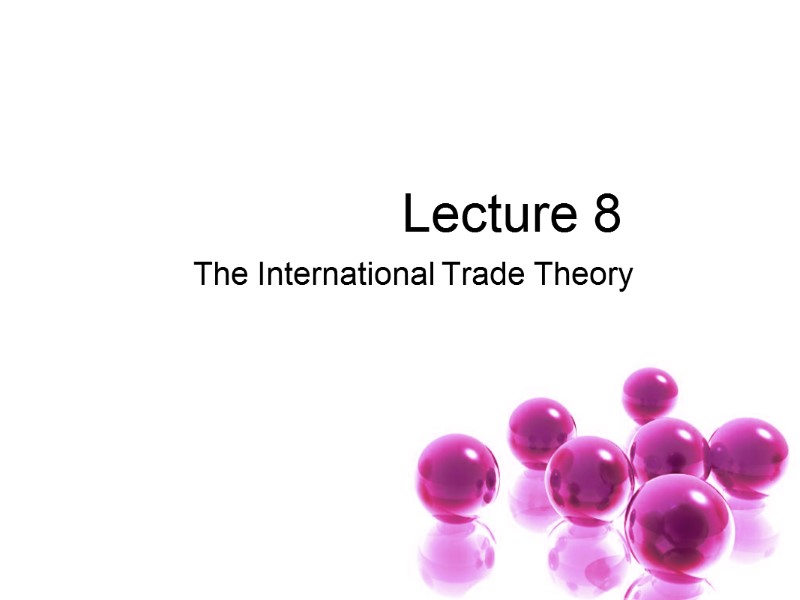
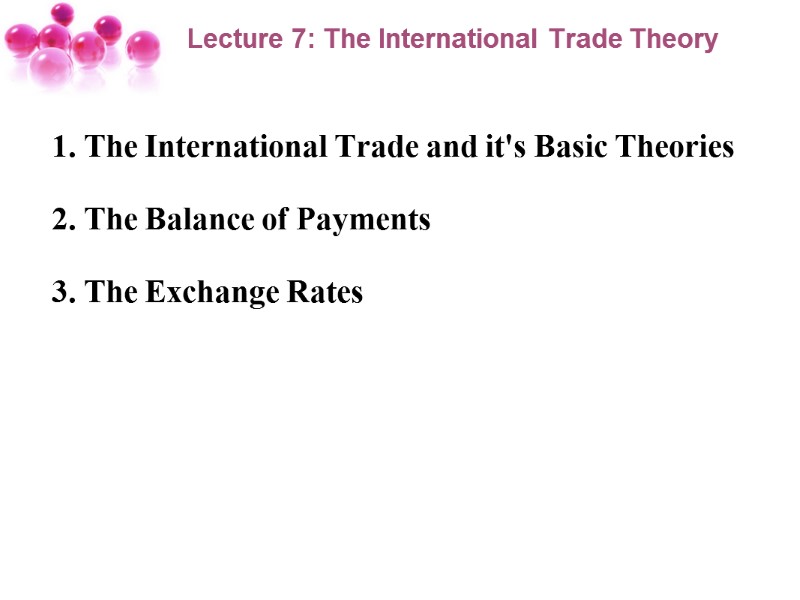

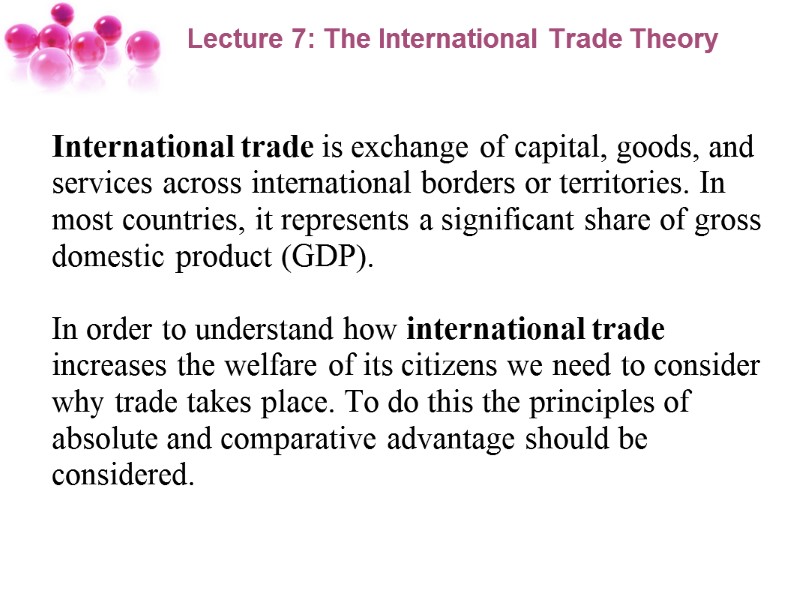



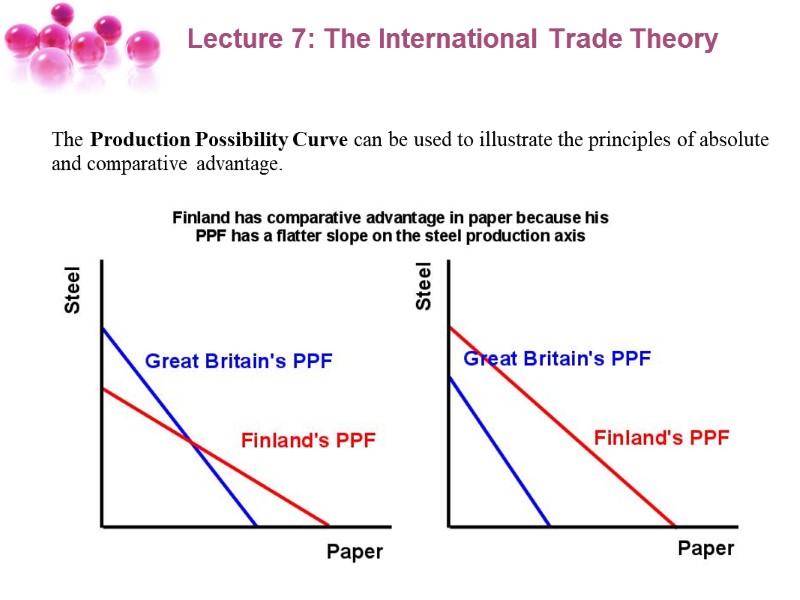




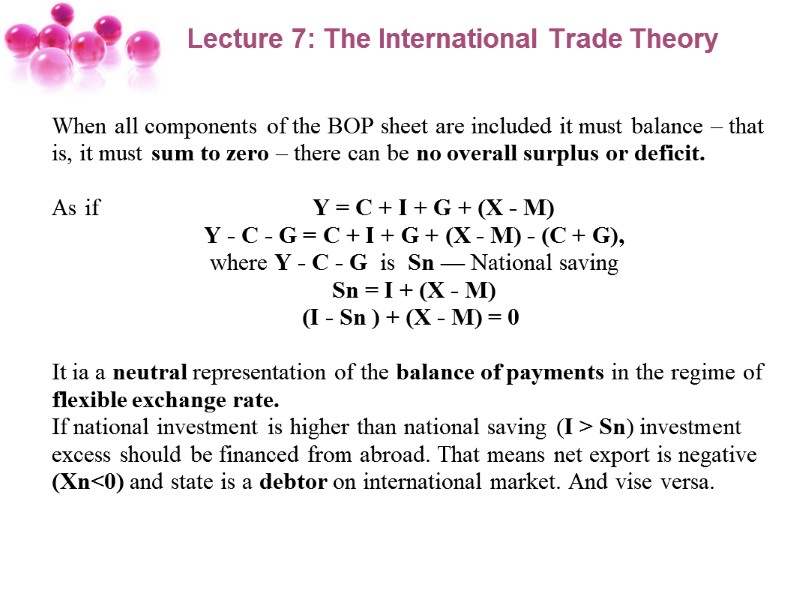






11688-lecture_8___the_international_trade_theory.ppt
- Количество слайдов: 19
 Lecture 8 The International Trade Theory
Lecture 8 The International Trade Theory
 Lecture 7: The International Trade Theory 1. The International Trade and it's Basic Theories 2. The Balance of Payments 3. The Exchange Rates
Lecture 7: The International Trade Theory 1. The International Trade and it's Basic Theories 2. The Balance of Payments 3. The Exchange Rates
 Lecture 7: The International Trade Theory Opportunity Cost – альтернативна вартість Balance of Payments (BOP) – платіжний баланс Foreign Exchange Reserves – валютні резерви
Lecture 7: The International Trade Theory Opportunity Cost – альтернативна вартість Balance of Payments (BOP) – платіжний баланс Foreign Exchange Reserves – валютні резерви
 Lecture 7: The International Trade Theory International trade is exchange of capital, goods, and services across international borders or territories. In most countries, it represents a significant share of gross domestic product (GDP). In order to understand how international trade increases the welfare of its citizens we need to consider why trade takes place. To do this the principles of absolute and comparative advantage should be considered.
Lecture 7: The International Trade Theory International trade is exchange of capital, goods, and services across international borders or territories. In most countries, it represents a significant share of gross domestic product (GDP). In order to understand how international trade increases the welfare of its citizens we need to consider why trade takes place. To do this the principles of absolute and comparative advantage should be considered.
 Lecture 7: The International Trade Theory The Principle of Absolute Advantage The main concept of absolute advantage is generally attributed to Adam Smith for his 1776 publication An Inquiry into the Nature and Causes of the Wealth of Nations. A country has an absolute advantage over it trading partners if it is able to produce more of a good or service with the same amount of resources or the same amount of a good or service with fewer resources.
Lecture 7: The International Trade Theory The Principle of Absolute Advantage The main concept of absolute advantage is generally attributed to Adam Smith for his 1776 publication An Inquiry into the Nature and Causes of the Wealth of Nations. A country has an absolute advantage over it trading partners if it is able to produce more of a good or service with the same amount of resources or the same amount of a good or service with fewer resources.
 Lecture 7: The International Trade Theory
Lecture 7: The International Trade Theory
 Lecture 7: The International Trade Theory The Principle of Comparative Advantage The Ricardian model focuses on comparative advantage. In a Ricardian model, countries specialize in producing what they produce best. A country has a comparative advantage in the production of a good or service that it produces at a lower opportunity cost than its trading partners. Some countries have an absolute advantage in the production of many goods relative to their trading partners. Some have an absolute disadvantage. They are inefficient in producing anything, relative to their trading partners. The theory of comparative costs argues that, it is better for a country that is inefficient at producing a good or service to specialise in the production of that good it is least inefficient at, compared with producing other goods.
Lecture 7: The International Trade Theory The Principle of Comparative Advantage The Ricardian model focuses on comparative advantage. In a Ricardian model, countries specialize in producing what they produce best. A country has a comparative advantage in the production of a good or service that it produces at a lower opportunity cost than its trading partners. Some countries have an absolute advantage in the production of many goods relative to their trading partners. Some have an absolute disadvantage. They are inefficient in producing anything, relative to their trading partners. The theory of comparative costs argues that, it is better for a country that is inefficient at producing a good or service to specialise in the production of that good it is least inefficient at, compared with producing other goods.
 Lecture 7: The International Trade Theory The Production Possibility Curve can be used to illustrate the principles of absolute and comparative advantage.
Lecture 7: The International Trade Theory The Production Possibility Curve can be used to illustrate the principles of absolute and comparative advantage.
 Lecture 7: The International Trade Theory Before the FTA, the US is able to produce and consume at point A and Columbia at point C. However, if the two coutries specilize in the production of the good for which they have a comparative advantage, and trade with the other, then both countries can consume beyond their production possibilities curve at points B and D respectively. This illustrates the gains from trade between the US and Columbia.
Lecture 7: The International Trade Theory Before the FTA, the US is able to produce and consume at point A and Columbia at point C. However, if the two coutries specilize in the production of the good for which they have a comparative advantage, and trade with the other, then both countries can consume beyond their production possibilities curve at points B and D respectively. This illustrates the gains from trade between the US and Columbia.
 Lecture 7: The International Trade Theory Consider that Finland has comparative advantage in production of Paper (X) and interior market sets 1X = 0,5Y. In A it is 1X =2Y. Obviously Finland will export cheap product X to Britain. World price will be 1X = 1Y. So after international trading in Britain consumer surplus rise from c to a+b+c+d. Producers loose a, because previously they had a+e and now only e. Net gain for A is b+d. In Finland consumers loose a part of consumer's surplus h+i, when producers get h+i+f. Net gain is f. So global gain is b+d+f.
Lecture 7: The International Trade Theory Consider that Finland has comparative advantage in production of Paper (X) and interior market sets 1X = 0,5Y. In A it is 1X =2Y. Obviously Finland will export cheap product X to Britain. World price will be 1X = 1Y. So after international trading in Britain consumer surplus rise from c to a+b+c+d. Producers loose a, because previously they had a+e and now only e. Net gain for A is b+d. In Finland consumers loose a part of consumer's surplus h+i, when producers get h+i+f. Net gain is f. So global gain is b+d+f.
 Lecture 7: The International Trade Theory Gains From Trade - specialization in production from division of labor, economies of scale, scope, and agglomeration; - a resulting increase in total output possibilities; - trade through markets from sale of one type of output for other, more highly valued goods. International Trade Policy — is a governmental policy governing trade with third countries. This covers tariffs, trade subsidies, import quotas, Voluntary Export Restraints, restrictions on the establishment of foreign-owned businesses, regulation of trade in services and other barriers to international trade.
Lecture 7: The International Trade Theory Gains From Trade - specialization in production from division of labor, economies of scale, scope, and agglomeration; - a resulting increase in total output possibilities; - trade through markets from sale of one type of output for other, more highly valued goods. International Trade Policy — is a governmental policy governing trade with third countries. This covers tariffs, trade subsidies, import quotas, Voluntary Export Restraints, restrictions on the establishment of foreign-owned businesses, regulation of trade in services and other barriers to international trade.
 Lecture 7: The International Trade Theory The balance of payments (BOP) sheet is an accounting record of all monetary transactions between a country and the rest of the world. These transactions include payments for the country's exports and imports of goods, services, and financial capital, as well as financial transfers. Sources of funds for a nation, such as exports or the receipts of loans and investments, are recorded as positive or surplus items. Uses of funds, such as for imports or to invest in foreign countries, are recorded as a negative or deficit item.
Lecture 7: The International Trade Theory The balance of payments (BOP) sheet is an accounting record of all monetary transactions between a country and the rest of the world. These transactions include payments for the country's exports and imports of goods, services, and financial capital, as well as financial transfers. Sources of funds for a nation, such as exports or the receipts of loans and investments, are recorded as positive or surplus items. Uses of funds, such as for imports or to invest in foreign countries, are recorded as a negative or deficit item.
 Lecture 7: The International Trade Theory When all components of the BOP sheet are included it must balance – that is, it must sum to zero – there can be no overall surplus or deficit. As if Y = C + I + G + (X - M) Y - C - G = C + I + G + (X - M) - (C + G), where Y - C - G is Sn — National saving Sn = I + (X - M) (I - Sn ) + (X - M) = 0 It ia a neutral representation of the balance of payments in the regime of flexible exchange rate. If national investment is higher than national saving (I > Sn) investment excess should be financed from abroad. That means net export is negative (Xn<0) and state is a debtor on international market. And vise versa.
Lecture 7: The International Trade Theory When all components of the BOP sheet are included it must balance – that is, it must sum to zero – there can be no overall surplus or deficit. As if Y = C + I + G + (X - M) Y - C - G = C + I + G + (X - M) - (C + G), where Y - C - G is Sn — National saving Sn = I + (X - M) (I - Sn ) + (X - M) = 0 It ia a neutral representation of the balance of payments in the regime of flexible exchange rate. If national investment is higher than national saving (I > Sn) investment excess should be financed from abroad. That means net export is negative (Xn<0) and state is a debtor on international market. And vise versa.
 Lecture 7: The International Trade Theory A nation with a trade deficit will experience reduction in its foreign exchange reserves which ultimately lowers (depreciates) the value of its currency. The cheaper currency renders the nation's goods (exports) more affordable in the global market place while making imports more expensive. After an intermediate period, imports are forced down and exports rise, thus stabilizing the trade balance and the currency towards equilibrium.
Lecture 7: The International Trade Theory A nation with a trade deficit will experience reduction in its foreign exchange reserves which ultimately lowers (depreciates) the value of its currency. The cheaper currency renders the nation's goods (exports) more affordable in the global market place while making imports more expensive. After an intermediate period, imports are forced down and exports rise, thus stabilizing the trade balance and the currency towards equilibrium.
 Lecture 7: The International Trade Theory The exchange rates (also known as the foreign-exchange rate, forex rate or FX rate) between two currencies specify how much one currency is worth in terms of the other. It is the value of a foreign nation’s currency in terms of the home nation’s currency. When we say exchange rate we usually mean nominal exchange rate. The "real exchange rate" (RER) is the purchasing power of two currencies relative to one another. It is based on the GDP deflator measurement of the price level in the domestic and foreign countries (P,Pf), which is arbitrarily set equal to 1 in a given base year.
Lecture 7: The International Trade Theory The exchange rates (also known as the foreign-exchange rate, forex rate or FX rate) between two currencies specify how much one currency is worth in terms of the other. It is the value of a foreign nation’s currency in terms of the home nation’s currency. When we say exchange rate we usually mean nominal exchange rate. The "real exchange rate" (RER) is the purchasing power of two currencies relative to one another. It is based on the GDP deflator measurement of the price level in the domestic and foreign countries (P,Pf), which is arbitrarily set equal to 1 in a given base year.
 Lecture 7: The International Trade Theory Equilibrium real exchange rate sets on intersection of Sn-I and Xn graphs. In this point the supply of the national currency as credit for abroad balances the demand for national currency presented foreigners buying net exports from the country.
Lecture 7: The International Trade Theory Equilibrium real exchange rate sets on intersection of Sn-I and Xn graphs. In this point the supply of the national currency as credit for abroad balances the demand for national currency presented foreigners buying net exports from the country.
 Lecture 7: The International Trade Theory The changes of the RER are instead informative on the evolution over time of the relative price of a unit of GDP in the foreign country in terms of GDP units of the domestic country. If all goods were freely tradable, and foreign and domestic residents purchased identical baskets of goods, purchasing power parity (PPP) would hold for the GDP deflators of the two countries, and the RER would be constant and equal to one.
Lecture 7: The International Trade Theory The changes of the RER are instead informative on the evolution over time of the relative price of a unit of GDP in the foreign country in terms of GDP units of the domestic country. If all goods were freely tradable, and foreign and domestic residents purchased identical baskets of goods, purchasing power parity (PPP) would hold for the GDP deflators of the two countries, and the RER would be constant and equal to one.
 Lecture 7: The International Trade Theory A flexible exchange rate system is a currency system that allows the exchange rate to be determined by supply and demand. A fixed exchange rate, sometimes called a pegged exchange rate, is a type of exchange rate regime wherein a currency's value is matched to the value of another single currency or to a basket of other currencies, or to another measure of value, such as gold.
Lecture 7: The International Trade Theory A flexible exchange rate system is a currency system that allows the exchange rate to be determined by supply and demand. A fixed exchange rate, sometimes called a pegged exchange rate, is a type of exchange rate regime wherein a currency's value is matched to the value of another single currency or to a basket of other currencies, or to another measure of value, such as gold.
 Lecture 7: The International Trade Theory The end is close!
Lecture 7: The International Trade Theory The end is close!

